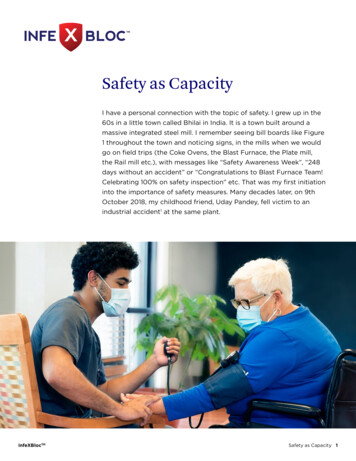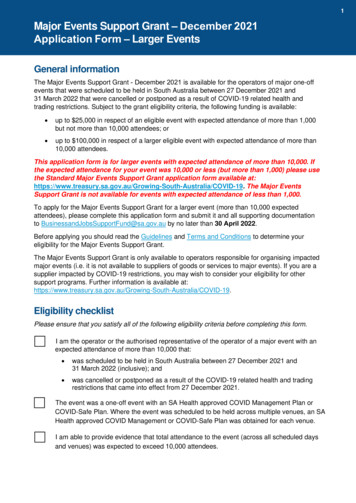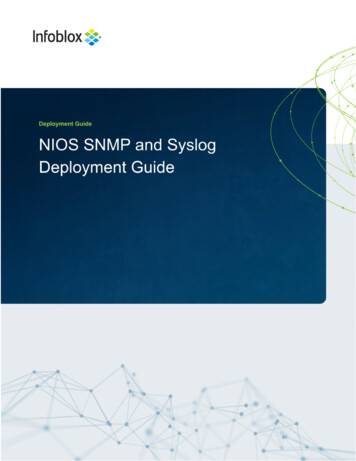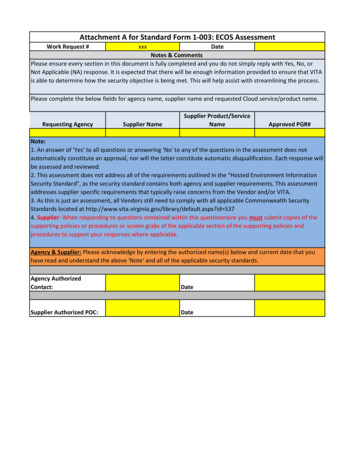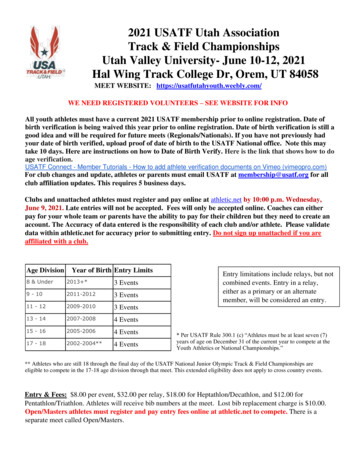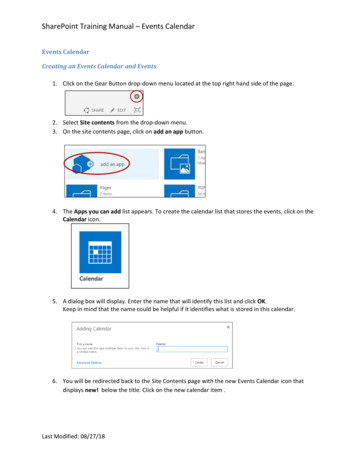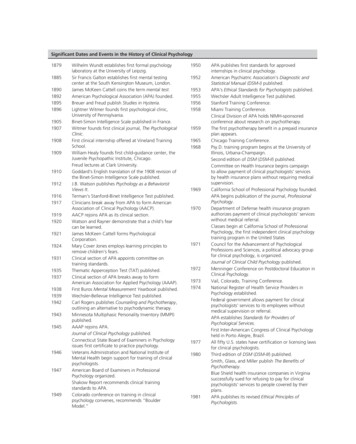
Transcription
Significant Dates and Events in the History of Clinical 39194219431945194619471949Wilhelm Wundt establishes first formal psychologylaboratory at the University of Leipzig.Sir Francis Galton establishes first mental testingcenter at the South Kensington Museum, London.James McKeen Cattell coins the term mental test.American Psychological Association (APA) founded.Breuer and Freud publish Studies in Hysteria.Lightner Witmer founds first psychological clinic,University of Pennsylvania.Binet-Simon Intelligence Scale published in France.Witmer founds first clinical journal, The PsychologicalClinic.First clinical internship offered at Vineland TrainingSchool.William Healy founds first child-guidance center, theJuvenile Psychopathic Institute, Chicago.Freud lectures at Clark University.Goddard's English translation of the 1908 revision ofthe Binet-Simon Intelligence Scale published.J.B. Watson publishes Psychology as a BehavioristViews It.Terman's Stanford-Binet Intelligence Test published.Clinicians break away from APA to form AmericanAssociation of Clinical Psychology (AACP).AACP rejoins APA as its clinical section.Watson and Rayner demonstrate that a child's fearcan be learned.James McKeen Cattell forms PsychologicalCorporation.Mary Cover Jones employs learning principles toremove children's fears.Clinical section of APA appoints committee ontraining standards.Thematic Apperception Test (TAT) published.Clinical section of APA breaks away to formAmerican Association for Applied Psychology (AAAP).First Buros Mental Measurement Yearbook published.Wechsler-Bellevue Intelligence Test published.Carl Rogers publishes Counseling and Psychotherapy,outlining an alternative to psychodynamic therapy.Minnesota Multiphasic Personality Inventory (MMPI)published.AAAP rejoins APA.Journal of Clinical Psychology published.Connecticut State Board of Examiners in Psychologyissues first certificate to practice psychology.Veterans Administration and National Institute ofMental Health begin support for training of clinicalpsychologists.American Board of Examiners in ProfessionalPsychology organized.Shakow Report recommends clinical trainingstandards to APA.Colorado conference on training in clinicalpsychology convenes, recommends “BoulderModel.”A00 KRAM1858 08 SE IFC.indd 97219731974197719801981APA publishes first standards for approvedinternships in clinical psychology.American Psychiatric Association's Diagnostic andStatistical Manual (DSM-I) published.APA's Ethical Standards for Psychologists published.Wechsler Adult Intelligence Test published.Stanford Training Conference.Miami Training Conference.Clinical Division of APA holds NIMH-sponsoredconference about research on psychotherapy.The first psychotherapy benefit in a prepaid insuranceplan appears.Chicago Training Conference.Psy.D. training program begins at the University ofIllinois, Urbana-Champaign.Second edition of DSM (DSM-II) published.Committee on Health Insurance begins campaignto allow payment of clinical psychologists' servicesby health insurance plans without requiring medicalsupervision.California School of Professional Psychology founded.APA begins publication of the journal, ProfessionalPsychology.Department of Defense health insurance programauthorizes payment of clinical psychologists' serviceswithout medical referral.Classes begin at California School of ProfessionalPsychology, the first independent clinical psychologytraining program in the United StatesCouncil for the Advancement of PsychologicalProfessions and Sciences, a political advocacy groupfor clinical psychology, is organized.Journal of Clinical Child Psychology published.Menninger Conference on Postdoctoral Education inClinical Psychology.Vail, Colorado, Training Conference.National Register of Health Service Providers inPsychology established.Federal government allows payment for clinicalpsychologists' services to its employees withoutmedical supervision or referral.APA establishes Standards for Providers ofPsychological Services.First Inter-American Congress of Clinical Psychologyheld in Porto Alegre, Brazil.All fifty U.S. states have certification or licensing lawsfor clinical psychologists.Third edition of DSM (DSM-III) published.Smith, Glass, and Miller publish The Benefits ofPsychotherapy.Blue Shield health insurance companies in Virginiasuccessfully sued for refusing to pay for clinicalpsychologists' services to people covered by theirplans.APA publishes its revised Ethical Principles ofPsychologists.11/06/13 12:08 AM
198319871988199019931994Joint Commission for the Accreditation of Hospitalsallows clinical psychologists to become members ofhospital medical staffs.DSM-III-R published.Conference on graduate education in psychology,Salt Lake City, Utah.American Psychological Society formed.California Supreme Court affirms right of clinicalpsychologists to independently admit, diagnose,treat, and release mental patients without medicalsupervision.Dick McFall publishes “Manifesto for a Science ofClinical Psychology.”Commander John L. Sexton and Lt. CommanderMorgan T. Sammons complete psychopharmacologyprogram at Walter Reed Army Medical Center,becoming first psychologists legally permitted toprescribe psychoactive drugs.DSM-IV published.Amendment to Social Security Act guaranteespsychologists the right to independent practice andpayment for hospital services under Medicare.Academy of Psychological Clinical Science isestablished.A00 KRAM1858 08 SE IFC.indd 2199519962000200220052006200820092013APA task force of clinical psychologists publishes listof empirically validated psychological therapies andcalls for students to be trained to use them.Dorothy W. Cantor becomes first president of APA tohold the Psy.D. rather than the Ph.D.DSM-IV-TR published.New Mexico grants prescription privileges to speciallytrained clinical psychologists.APA sponsors a Presidential Task Force onevidencebased practice.Psychologists win a second settlement in two years infederal court alleging that managed care companiesconspired to reduce and delay provider payments inviolation of federal law.The U.S. House of Representatives passes legislationrequiring mental health parity: The Paul WellstoneMental Health and Addiction Equity Act of 2007.University of Illinois becomes the first PCSASaccredited program.DSM-5 published.11/06/13 12:08 AM
Eighth EditionIntroduction to Clinical PsychologyGeoffrey P. KramerDouglas A. BernsteinVicky PharesBoston Columbus Indianapolis New York San Francisco Upper Saddle RiverAmsterdam Cape Town Dubai London Madrid Milan Munich Paris Montréal TorontoDelhi Mexico City São Paulo Sydney Hong Kong Seoul Singapore Taipei TokyoA01 KRAM1858 08 SE FM.indd 111/06/13 12:55 AM
Editor in Chief: Ashley DodgeExecutive Editor: Susan HartmanEditorial Project Manager: Reena DalalVice President/Director of Marketing: Brandy DawsonExecutive Marketing Manager: Wendy AlbertMarketing Assistant: Frank AlarconDigital Media Editor: Rachel ComerfordManaging Editor: Denise ForlowProject Manager, Production: Annemarie FranklinManufacturing Buyer: Diane PeiranoArt Director: Jayne ConteCover Designer: Karen NoferiComposition: Laserwords Pvt Ltd, IndiaCredits and acknowledgments borrowed from other sources and reproduced, with permission, in this textbook appear on appropriate page within text (or onpage 517).Copyright 2014, 2009, 2003 by Pearson Education, Inc. All rights reserved. Printed in the United States of America. This publication is protected by Copyrightand permission should be obtained from the publisher prior to any prohibited reproduction, storage in a retrieval system, or transmission in any form or by anymeans, electronic, mechanical, photocopying, recording, or likewise. To obtain permission(s) to use material from this work, please submit a written request toPearson Education, Inc., Permissions Department, One Lake Street, Upper Saddle River, New Jersey 07458 or you may fax your request to 201-236-3290.Many of the designations by manufacturers and seller to distinguish their products are claimed as trademarks. Where those designations appear in this book, andthe publisher was aware of a trademark claim, the designations have been printed in initial caps or all caps.Library of Congress Cataloging-in-Publication DataKramer, Geoffrey P.Introduction to clinical psychology / Geoffrey P. Kramer, Douglas A. Bernstein, Vicky Phares. — Eighth edition.pages cmIncludes bibliographical references and indexes.ISBN 0-205-87185-2 (alk. paper)1. Clinical psychology. I. Bernstein, Douglas A. II. Phares, Vicky. III. Title.RC467.N54 2014616.89—dc23201301289510987654321ISBN-10: 0-205-87185-2ISBN-13: 978-0-205-87185-8A01 KRAM1858 08 SE FM.indd 211/06/13 12:55 AM
contentSPrefaceviiAcknowledgmentsviiiSection I Basic Concepts1Chapter 1 What Is Clinical Psychology? 1An Overview of Clinical Psychology 2Clinical Psychologists at Work 8Clinical Psychology in the 21st Century 14Chapter Summary18Chapter 2 Clinical Psychology’s Past and Present22The Roots of Clinical Psychology 22Clinical Psychology Begins to Grow 29The Major Approaches Develop 33The Pros and Cons of Taking a Specific Approach 44Chapter SummarySection II Assessment4649Chapter 3 Basic Features of Clinical Assessment49An Outline of the Assessment Process 50The Goals of Clinical Assessment 54Clinical Judgment and Decision Making 63Psychometric Properties of Assessment Instruments 67Other Factors Affecting Assessment Choices 70Communicating Assessment Results 73Ethical Considerations in Assessment 76Chapter Summary77Chapter 4 Interviewing and Observation in ClinicalPsychology 82Clinical Interview Situations 82Interview Structure 87Stages in the Interview 91Research on the Interview 97Observational Assessment: Goals and Benefits 100Observational Assessment: Approaches 102Research on Observational Assessment 108Chapter Summary110Chapter 5 Testing in Clinical Psychology116Basic Concepts in Psychological Testing 116Cultural Fairness and Bias in Psychological Tests 122Tests of Intellectual Functioning 124Tests of Attitudes, Interests, Preferences, and Values 131Tests of Psychopathology and Personality 132iiiA01 KRAM1858 08 SE FM.indd 311/06/13 12:55 AM
ivContentsThe Current Status of Psychological Testing 142The Future of Psychological Testing 144Chapter Summary 144Section III Clinical Interventions151Chapter 6 Basic Features of Clinical Interventions 151Overview of Clinical Interventions 151The Participants in Psychotherapy 153The Goals of Clinical Interventions 162Ethical Guidelines for Clinical Interventions 164Some Practical Aspects of Clinical Intervention 167Chapter Summary 171Chapter 7 Psychodynamic and HumanisticPsychotherapies 176Psychoanalysis 176Psychodynamic Psychotherapy 187Humanistic Psychotherapy 193Other Humanistic Approaches 200Chapter Summary 204Chapter 8 Behavioral and Cognitive-BehaviorPsychotherapies 208Behavior Therapy 208Cognitive Therapy 218Cognitive-Behavior Therapy 227The Current Status of Cognitive-Behavior Therapy 232Chapter Summary 232Chapter 9 Other Modes of Clinical Intervention236Group Therapy 237Couples and Family Therapy 240Community Psychology 246Prevention 247Self-Help 250Other Approaches 251Technological Innovations Influencing Psychological Treatment 254Psychotherapy Integration 256Chapter Summary 257Chapter 10 Research on Clinical Intervention263Studying Individual Psychological Treatments 264Studying Other Modes of Intervention 274Issues and Concerns About Research on Therapy 276Chapter Summary 279Section IV Some Clinical Specialties284Chapter 11 Clinical Child Psychology284A Brief History of Clinical Child Psychology 285Characteristics Unique to Clinical Child Psychology 286A01 KRAM1858 08 SE FM.indd 411/06/13 12:55 AM
Contents vClinical Assessment of Children 292Specific Childhood Disorders 296Treatment and Prevention of Childhood Disorders 302The Future of Clinical Child Psychology 305Chapter Summary308Chapter 12 Health Psychology 315What is Health Psychology? 315Risk Factors for Illness 322Illness Prevention and Treatment Programs 324A Health Psychology Case Example 328Improving Adherence to Medical Treatment Regimens 329Chapter Summary331Chapter 13 Clinical Neuropsychology 337A Brief History of Neuropsychology 338Basic Principles of Neuropsychology 340Patterns of Neuropsychological Dysfunction 344Neuropsychological Assessment 349Neuropsychological Approaches to Psychopathology 351The Current Status of Clinical Neuropsychology 354Chapter Summary355Chapter 14 Forensic Psychology359The Scope of Forensic Psychology 359Criminal Competence and Responsibility 360Predicting Dangerousness 367Assessing Psychological Status in Civil Trials 368Psychological Autopsies and Criminal Profiling 370Child Custody and Parental Fitness 372Mental Health Experts in the Legal System 376Chapter Summary378Section V The Future of Clinical Psychology382Chapter 15 Professional Issues in ClinicalPsychology 382Professional Training 383Professional Regulation 390Professional Ethics 393Professional Independence 399Professional Multicultural Competence 403The Future of Clinical Psychology 406Chapter Summary409Chapter 16 Getting into Graduate School in ClinicalPsychology 415What Types of Graduate Programs Will Help Me Meet My CareerGoals? 415Am I Ready to Make the Commitment Required by Graduate Programsat this Time in My Life? 419A01 KRAM1858 08 SE FM.indd 511/06/13 12:55 AM
viContentsAre My Credentials Strong Enough for Graduate School in ClinicalPsychology? 421Given My Credentials, to What Type of Program Can I RealisticallyAspire? 423I Have Decided to Apply to Graduate School in Clinical Psychology. WhatShould I Do First? 424Should I Apply to a Master’s Degree Program and Complete It Before IApply to a Doctoral Program? 424If I Choose to Terminate My Training After Earning a Master’s Degree,Will My Opportunities for Doing Clinical Work Be Limited? 425Application Procedures 425Other Important Questions 440Chapter Summary 441ReferencesName Index445493Subject Index 507CreditsA01 KRAM1858 08 SE FM.indd 651511/06/13 12:55 AM
PrefaceIn the seven previous editions of this book, we tried to accomplish three goals. First, we wanteda book that, while appropriate for graduate students, was written especially with sophisticatedundergraduates in mind. Many undergraduate psychology majors express an interest in clinicalpsychology without having a clear understanding of what the field involves and requires. An evenlarger number of nonmajors also wish to know more about clinical psychology. We felt that bothgroups would benefit from a thorough survey of the field which does not go into all the detailstypically found in graduate study only texts.Second, we wanted to present a scholarly portrayal of the history of clinical psychology, itsscope, functions, and future that reviewed a full range of theoretical perspectives. Our goal is topresent approaches to clinical psychology—psychodynamic, relational, humanistic, cognitivebehavioral, systems, group, etc.—fairly, highlighting the strengths and weaknesses of the empiricalevidence supporting each of them. We do champion the empirical research tradition of clinicalpsychology throughout the book because we believe it is a necessary and useful perspective for allclinicians to follow, regardless of their theoretical orientation.Third, we wanted our book to be interesting and enjoyable to read. Because we like beingclinical psychologists and because we enjoy teaching, we tried to create a book that communicatesour enthusiasm for its content.Though we are still guided by the above goals, we sought to make some significant changesin the eighth edition. Since our last edition, numerous changes have occurred in clinical psychology and in the health care delivery system, both in the United States and internationally.Accordingly, we have undertaken a comprehensive updating of research and other material in allchapters. With over 900 new references, we have described how research has led to new ways toconceptualize, assess, and treat psychological dysfunction. Some of the other significant changesare listed below.New To This Edition New pedagogical features. In addition to the updated study/discussion questions, andupdated websites, the new features include suggestions for movies and memoirs, and bibliographical references at the end of each chapter. New case material. Cases have been updated and their number increased in order to makethe material more compelling for students. Updated diagnostic criteria. The new edition discusses changes made in the DSM-5 and thecontroversies that continue to surround diagnostic classification. Greater integration of research and practice. Rather than presenting these topics pittedagainst one another, we stress the importance of both and highlight the growing consensus created by focusing on clinical utility; we synthesize the Common Factors andEvidence-Based approaches to effectiveness research and update discussion of treatmentplanning. Discussion of new mental health delivery models. We discuss how technologies have affectedthe options for delivering mental health services, including going well beyond the traditionalindividual psychotherapy model. Revised presentation of several assessment instruments. We have included discussion of thePAI, MMPI-2, and MMPI-2 Restructured Clinical Scales and others; expanded discussionof cultural fairness and bias in psychological testing; revised and integrated our presentationof clinical versus actuarial prediction. Updated topics of relevance to students. Many topics that are of particular interest to students have been updated, including the evolving roles of technology and social media,information on careers within clinical psychology, the use of evidence-based practices;new techniques such as mindfulness which have become integral to the field; the status ofcomplementary and alternative medicine.viiA01 KRAM1858 08 SE FM.indd 711/06/13 12:55 AM
viiiPreface Updated information on getting into graduate school. This edition informs students aboutthe new GRE scoring system and provides updated information on how to apply to graduateschool, with special focus on new hardcopy and on-line resources. Updated discussion of clinical psychology training. We’ve added information on the newPCSAS accreditation system, the current internship crisis in clinical psychology, new choicesin graduate training, and the increasing importance of multicultural competence. Updated discussion of popular therapies such as relational psychodynamic approaches,motivatinal interviewing, and emotion-focused therapy.This text is available in a variety of formats—digital and print. To learn more about ourprograms, pricing options, and customization, visit www.pearsonhighered.com.AcknowledgmentsWe want to thank several people for their valuable contributions to this book. We wish to expressour appreciation to Catherine Stoney for her help in updating the health psychology chapter, toJoel Shenker for his help in updating the neuropsychology chapter, and to Elaine Cassel for herhelp in updating the chapter on forensic psychology. We would also like to thank Lauren Snoeyinkfor her comments on chapter drafts.Countless undergraduate and graduate students asked the questions, raised the issues, andexplored multiple perspectives that have found their way into the text; they are really the peoplewho stimulated the creation of this book, and who continue to make us want to revise and updateits content. We thank them all. We would also like to thank Susan Hartman, Jeff Marshall, ReenaDalal, and Lindsay Bethoney at Pearson Prentice Hall and Haseen Khan at Laserwords for theirhelp and patience in guiding the creation of this latest edition. Finally, we thank our families,loved ones, and friends for their support throughout this project. Your infinite patience and kindencouragement is a debt we can never repay.Geoffrey P. KramerDouglas A. BernsteinVicky PharesA01 KRAM1858 08 SE FM.indd 811/06/13 12:55 AM
Significant Dates and Events in the History of Clinical Psychology 1879 Wilhelm Wundt establishes first formal psychology laboratory at the University of Leipzig. 1885 Sir Francis Galton establishes first mental testing center at the South Kensington Museum, London. 1890 James McKeen Cattell coins the term mental test.

